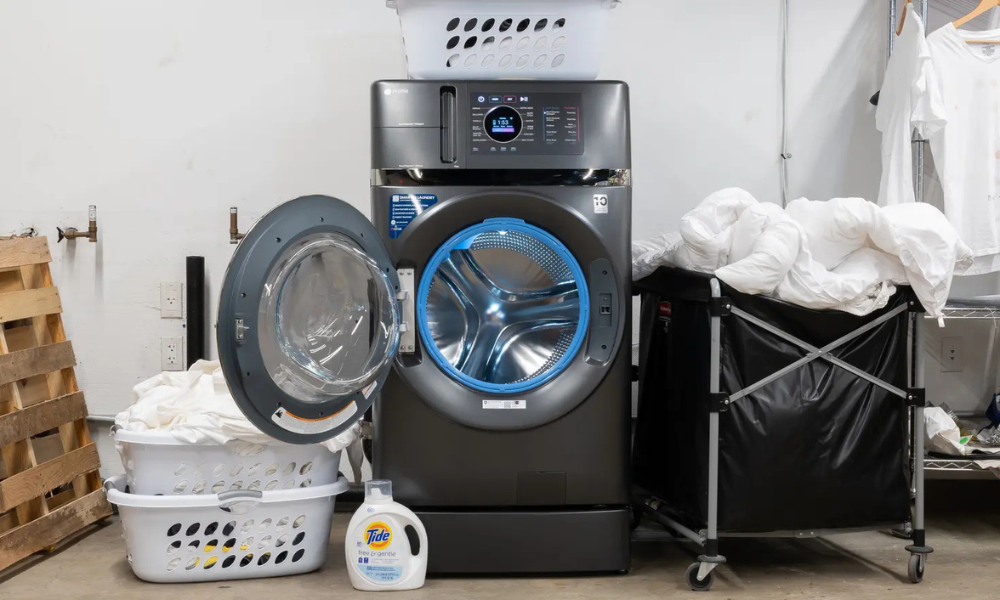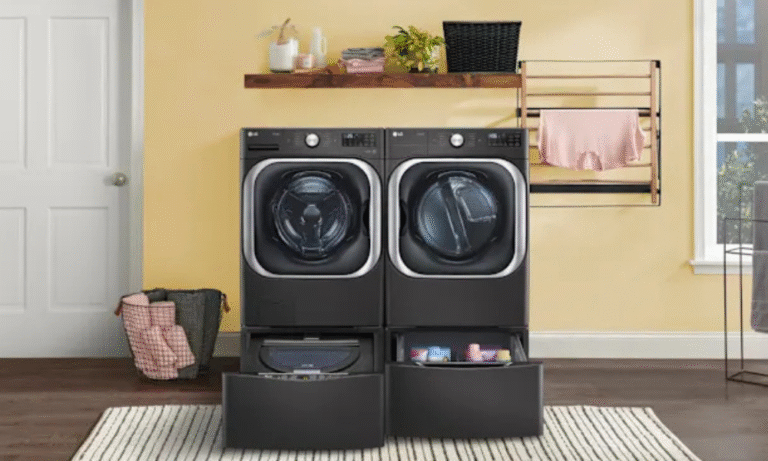Estimated reading time: 12 minutes
Last updated on August 23rd, 2025 at 02:10 am
Efficiency and convenience are crucial when it comes to domestic duties in today’s fast-paced society. The combination washing machine and dryer is one piece of equipment that has grown in popularity for its capacity to simplify laundry operations. These appliances provide several benefits by merging the washing and drying functions into a single device. In this post, we’ll go into the idea of combination washers/dryers and examine their operation and advantages.
Understanding Combined Washing Machine Dryers
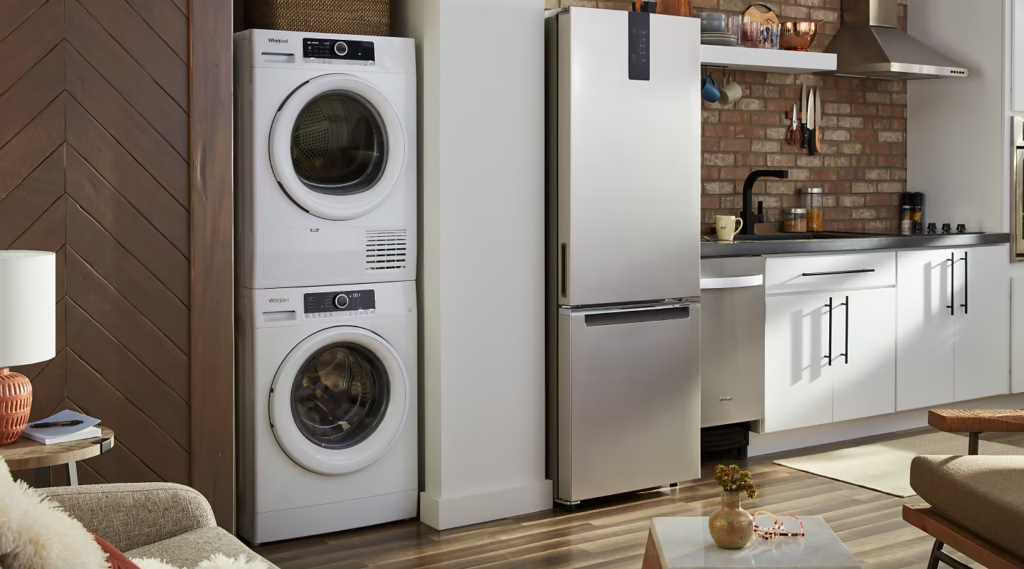
Photo Credit: whirlpool
What is a Washing Machine Dryer?
A washer-dryer combination, commonly referred to as a washing machine dryer, is a multi-purpose appliance that combines the washing and drying processes into a single device. By doing away with the necessity for separate washing and drying machines, this creative solution frees up important space in smaller houses or apartments. Washer-dryer combinations offer a practical and effective laundry solution for contemporary houses by merging these two tasks.
How Does a Washing Machine Dryer Work?
With the help of modern technology, washing and drying cycles are effortlessly combined in washing machine dryers. These appliances make use of sophisticated drum systems that can carry out both tasks automatically. The washing machine cleans the garments by agitating them with water, detergent, and water during the washing cycle. The same drum changes to a drying mode when the washing operation is finished. It efficiently dries the garments by moving heated air around to remove moisture.
Combination washer-dryers provide efficiency and convenience in a variety of ways. They save time and effort by removing the need to move laundry from the washing machine to a different dryer. Second, there is no need to wait for the garments to dry before removing them from the washing machine because drying happens right away after washing. For those who have little access to outside drying space or during bad weather, this feature is very useful.
The energy efficiency of washer-dryer sets is another benefit. These appliances maximize energy and water use, cutting down on waste and maintenance expenses. Washer-dryer combinations employ condensation or heat pump technology to remove moisture from the air during the drying process, in contrast to standalone dryers, which need a vent to release hot air. With the help of this technology, drying outcomes are still effective while using less energy.
Additionally, user comfort is a consideration in the construction of washer-dryer combinations. They frequently provide a variety of wash and dry cycles, letting consumers choose the best options for their individual laundry needs. Even more sophisticated capabilities are available on some models, such delay start, which lets consumers plan when their laundry cycles will start. These practical features increase adaptability and guarantee that washing duties may be customized to match different schedules.
The functionality of washer-dryer combinations is revolutionary in terms of conserving space. These appliances are perfect for tiny houses, flats, or laundry rooms with limited space because of their compact form. They reduce the need for separate machines by merging the washing and drying tasks into one device, freeing up valuable floor space. As a result, they are especially common in cities with limited space.
Benefits of Using a Washing Machine Dryer
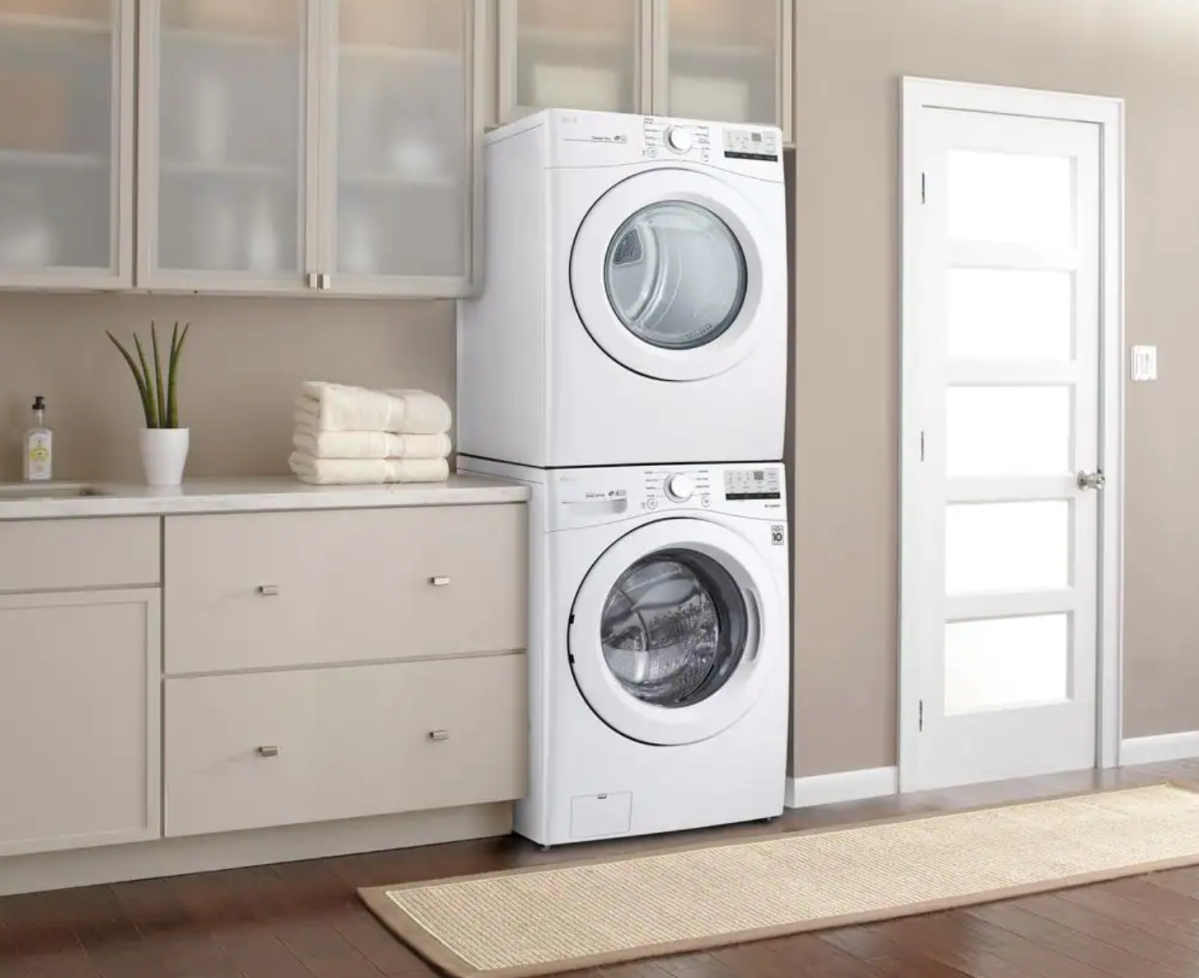
Photo Credit: bobvila
In washing machines, design has a big impact on the aesthetics, usability, and user experience. Here are some significant elements emphasizing the function of design in washing machines:
Visual Appeal
Washing machine designs have improved and are now more aesthetically pleasing, integrating in well with the overall style of contemporary houses. Manufacturers make an investment in producing modern, slick, and fashionable designs that go with many types of home decor. This enables the washing machine to complement the laundry room attractively or, if necessary, even merge into adjacent living areas.
User-Friendly Interfaces
The design of the washing machine’s control panel and user interfaces is essential for delivering a simple and straightforward user experience. Users may choose preferred settings, programs, and choices with ease thanks to clear and simple-to-understand buttons, knobs, and displays. Clear labeling and thoughtful control placement improve user-friendliness and lessen misunderstanding.
Ergonomics
For a washing machine to operate ergonomically, the physical layout and design are crucial. To maximize user comfort and convenience, factors including the machine’s height, the door’s accessibility, and the location of the control panel are taken into mind. A favorable user experience is facilitated by simple loading and unloading of the laundry as well as clear view of the drum.
Space optimization
To fit different living areas, washing machines come in a range of sizes and configurations. The design allows for freestanding or built-in installation choices while taking into account space limitations. Larger capacity models serve homes with more laundry demands, while compact washing machines are made for smaller living areas.
Durability and lifespan
A washing machine’s design is essential to maintaining its lifespan and durability. The durability, high quality, and well-engineered parts of the appliance all contribute to its dependability. The machine runs at its peak throughout its career thanks to thoughtful design decisions about load-bearing capacity, drum structure, and suspension mechanisms that assist limit wear and tear.
Noise and Vibration Control
Washing machines are intended to reduce operating disruptions and have good noise and vibration control. Innovative design elements that dampen noise and decrease vibrations during wash and spin cycles include balanced drum systems, anti-vibration technologies, and noise insulation materials. This improves the overall user experience and minimizes disruptions to the environment.
Safety Features
Design considerations also encompass safety features in washing machines. To shield users from potential risks, the design includes water leakage prevention features, strong door locks, and child lock systems. Users, especially those who have small children or pets, benefit from the piece of mind these safety features offer.
Accessibility and Inclusivity
Designing washing machines with accessibility in mind ensures that individuals with mobility challenges or disabilities can use the appliance with ease. The machine is made more user-friendly by attributes such a front-loading design, easily placed controls, and possibilities for changeable heights.
Washing machines work to improve both the overall user experience and their functionality and efficiency by introducing smart design aspects. A well-designed washing machine not only successfully completes its primary task but also improves the user’s everyday experience through aesthetics, use, and convenience.
Considerations for Choosing a Washing Machine Dryer
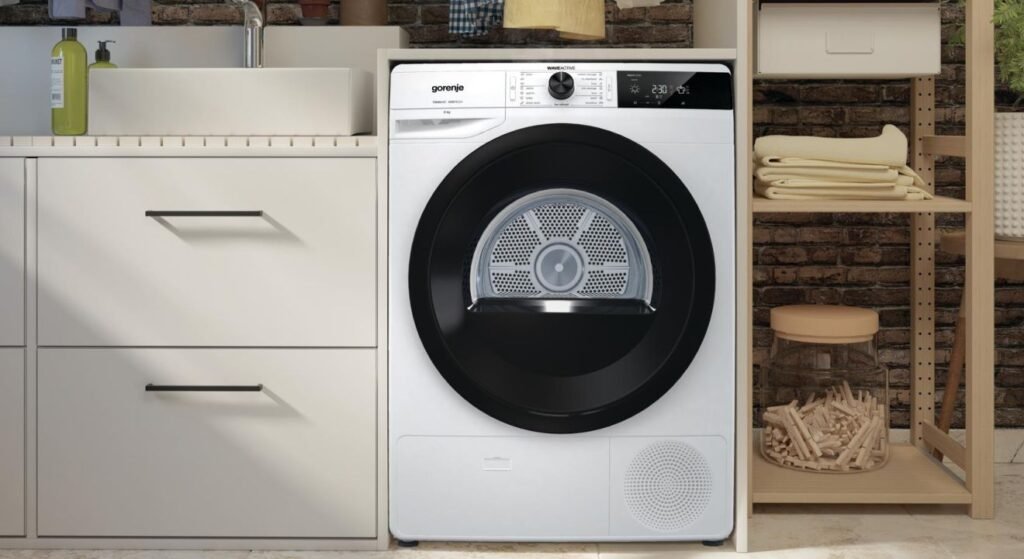
Photo Credit: international
There are a number of crucial factors to take into account while selecting a washing machine dryer. These elements will assist you in choosing a unit that suits your unique requirements and tastes. Here are some crucial things to remember:
Capacity
Determine the capacity you require based on your laundry needs. Take into account your household’s size, how often you do laundry, and the typical load size. The capacity of a washer-dryer combo is often lower than that of individual washing machines and dryers, so be sure it can handle your regular laundry load.
Space Availability
Measure the available space in your laundry area or desired location for the washer-dryer combo. Make that the unit’s dimensions fit comfortably in the designated location. Based on the layout of your room and your preferences for design, decide whether you need a freestanding or built-in model.
Functions and Features
Assess the range of functions and features offered by different washer-dryer models. Consider features like a variety of wash programs, drying choices, temperature control, load monitoring, steam functions, and customizability. Select a washer and dryer that offers the features and functionalities you need for your laundry.
Energy Efficiency
Verify the washer-dryer combo’s energy efficiency rating. Choose vehicles with excellent energy efficiency ratings to guarantee less energy use and long-term cost savings. Energy-efficient products frequently include labels like ENERGY STAR, which attest to their adherence to energy-saving guidelines.
Water Efficiency
Consider the water efficiency of the washer-dryer combo, especially if you live in an area with water scarcity or high water costs. To reduce water use, look for models with load detecting technology, adjustable water levels, and water-saving features.
Performance and Durability
Examine the effectiveness and toughness of several washer-dryer machines. Read testimonials, look up ratings, and take the brand’s reputation into account. To ensure enduring performance and dependability, look for machines with positive client reviews.
Noise and Vibration
Consider the noise and vibration levels produced by the washer-dryer combo during operation. To reduce disruptions in your living space, look for devices with noise reduction and anti-vibration characteristics.
Maintenance and Cleaning
Consider how simple it is to maintain and clean the washer-dryer combination. Choose models with self-cleaning capabilities, easily accessible filters, and manageable maintenance needs. The best performance and lifespan will be provided by units that are simple to maintain and clean.
Price and Budge
Determine your budget range for a washer-dryer combo and compare prices across different models. Take into account the potential long-term cost reductions offered by energy-efficient appliances. Find a product that strikes a balance between the features and functionalities you value and the price.
Warranty and After-Sales assistance
Verify the manufacturer’s warranty policy and the existence of any after-sales assistance. A trustworthy warranty and excellent customer service may offer assurance and support in the event of any problems or worries.
By taking into account these elements, you may choose a washing machine dryer that best meets your needs, assuring a positive laundry experience for years to come.
Frequently Asked Questions
1. Can a washing machine dryer handle large or bulky items?
Yes, to a certain extent, a washing machine dryer can manage bulky or heavy objects. However, it’s crucial to take into account the washer-dryer combinations’ capacity restrictions. The drying capacity is often less than the washing capacity due to the combination design. To be sure it can hold larger objects, it is advised to verify the specs of the particular model you are interested in.
In order to ensure appropriate agitation and tumbling, it is advised to allow ample room while washing and drying large or bulky goods. The machine may clean ineffectively or dry insufficiently if it is overloaded. It could be advisable to use a laundromat or a separate dryer for those particular goods if the item is too large to fit comfortably in the drum.
2. Is it possible to run only the washing or drying cycle separately?
Yes, the majority of washer-dryer sets allow you to run separate washing or drying cycles. Depending on your needs, you may decide whether to wash or dry your clothes separately. The control panel often has choices for choosing particular settings and operations for either drying or washing.
Simply load your clothes, choose the correct wash program, make the necessary setting adjustments, and start the cycle to run only the washing cycle. Similarly, if you’re only using the drying cycle, put your moist items in the washer, select the right drying program, tweak the parameters, and start the drying cycle.
3. How long does a typical wash and dry cycle take in a combined appliance?
Depending on the chosen program, the size of the load, and the amount of moisture in the clothes, a full wash and dry cycle in a washer-dryer combo can take anywhere from one to three hours. An entire cycle can take between two and four hours on average.
It’s vital to keep in mind that washer-dryer combinations often take longer to dry than standalone dryers do since they have a lesser drying capacity and require more time to dry properly. When time is of the essence, certain models do, however, include rapid wash or express wash choices for shorter wash cycles.
4. Are washing machine dryers as effective as separate washers and dryers?
Washing machine dryers are made to be successful at both drying and washing clothes. The performance of integrated appliances has improved as a result of technological developments. It’s important to keep in mind, though, that the performance could not be exactly the same as that of separate washers and dryers.
Given that a washer-dryer combination may not be as effective at drying clothes as a separate dryer, larger loads may take longer to dry. A washer-dryer combo’s total capacity is often lower than that of standalone appliances as well. Therefore, a separate washer and dryer can be more appropriate if you routinely wash large loads or have high drying demands.
5. Can I install a washing machine dryer in any location of my home?
Specific considerations must be made before installing a washing machine dryer. In general, you may put a washer-dryer combination in a number of rooms in your house, such as the kitchen, bathroom, or laundry room. However, there are a few crucial things to remember:
– Ventilation: Make sure the dryer has the right amount of ventilation. While some appliances employ condensation or heat pump technology and are ventless, others need access to a ventilation outlet.
– Plumbing: Verify if the selected site has drainage and water supply connections. While some versions must be directly linked to a water source, others may be manually filled or attached to a faucet.
– Electrical: Confirm that the washer-dryer combo’s electrical requirements are met in the installation area’s electrical system. Included in this are the necessary voltage, amperage, and outlet type for the appliance.
It’s essential to refer to
If you have any questions about whether a certain place is appropriate, read the manufacturer’s instructions and get advice from a specialist.
Conclusion
In conclusion, washing machine dryers provide houses with a practical and adaptable laundry solution. They provide the freedom to run separate washing or drying cycles and have various cycle lengths, so they can manage large or bulky things to a certain extent. Even while they might not have the same capacity as separate washers and dryers, they nevertheless provide benefits including saving time, money, and space. It’s crucial to evaluate your unique demands when thinking about a washer-dryer combo and select a model that best satisfies them.
